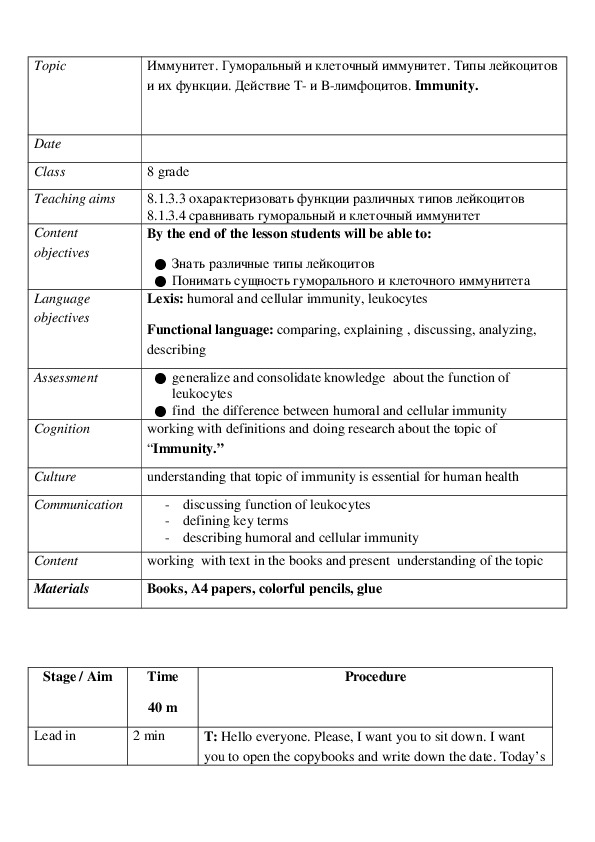Урок " Иммунитет" показывает виды иммунитете : клеточный и гуморальный. Данный урок может быть использован на уроке биологии с изучением на английском языке. Все этапы урока идут с логическим переходом. При написании плана учитывался уровень знания учащимися английского языка. Урок оканчивается рефлексией.
иммунитет.docx
Topic
Date
Class
Teaching aims
Content
objectives
Language
objectives
Assessment
Cognition
Иммунитет. Гуморальный и клеточный иммунитет. Типы лейкоцитов
и их функции. Действие Т и Влимфоцитов. Immunity.
8 grade
8.1.3.3 охарактеризовать функции различных типов лейкоцитов
8.1.3.4 сравнивать гуморальный и клеточный иммунитет
By the end of the lesson students will be able to:
● Знать различные типы лейкоцитов
● Понимать сущность гуморального и клеточного иммунитета
Lexis: humoral and cellular immunity, leukocytes
Functional language: comparing, explaining , discussing, analyzing,
describing
● generalize and consolidate knowledge about the function of
● find the difference between humoral and cellular immunity
working with definitions and doing research about the topic of
“Immunity.”
leukocytes
Culture
understanding that topic of immunity is essential for human health
Communication
discussing function of leukocytes
defining key terms
describing humoral and cellular immunity
Content
Materials
working with text in the books and present understanding of the topic
Books, A4 papers, colorful pencils, glue
Stage / Aim
Time
40 m
Lead in
2 min
Procedure
T: Hello everyone. Please, I want you to sit down. I want
you to open the copybooks and write down the date. Today’s Warm up
5 min
( to set the
context and
activate prior
knowledge)
Presentation
10 min
( to present the
Immunity)
lesson is going to focus on “Immunity.”. After today’s
lesson you will be able to describe the humoral and cellular
immunity and the difference between humoral and cellular
immunity . We will start with Explanation and we will finish
with Activity.
T: Before we start I want you to open the books on page 75
and think about how does your body gain immunity?.
Ss: Students brainstorming how does your body gain
immunity
T: Well done. Now, Let’s work with new terminology. I
want you to open the books on page7576 «Кeyword»
Find keywords in the text and write them
(Ss: Students find words in the text and and discuss it in
groups and with teacher (Attachment 0).
T: Brilliant! Let’s practice these words together. I want you
to repeat these words after me!
Now, moving on to Explanation let’s open the text on pages
7579 and listen to me?
ICQ: Do we have to read the text on page 75 or 79? (75)?
Do you have to read the text or listen to me? (Listen to you)
Иммунитет –это способность организма сопротивляться
инфекциями любым чужеродным частицам. Основы
учения об иммунитете разработал российский ученый
И.И. Мечников и немецкий ученый П. Эрлих.
Защиту организма от инфекций обеспечивают белые
клетки кровилейкоциты. Они защищают организм двумя
способами:
1) уничтожая микробовфагоцитоз.2)
вырабатывая специальные защитные белкиантитела,
убивающие микробов или помечающие из для уничтожения фагоцитами.
На основании способа уничтожения микробов иммунитет
делят на клеточный ( фагоцитоз) и гуморальный
( антитела).
Фагоцитоззахват твердых частиц с помощью
ложноножек. К активному фагоцитозуспособны амеба и
многие виды лейкоцитов, их называют фагоцитами.
Антителаособые
белки, которые вырабатывают
некоторые виды лимфоцитов в ответ на введение
чужеродных веществ –антигенов.
Выделяют 5 видов лейкоцитов( Работа по таблице№3
стр.77)
Тлимфоциты созревают в тимусе, обеспечивают
клеточный иммунитет.
Влимфоциты созревают в красном костном мозге,
обеспечивают гуморальный иммунитет.
T: Now let’s move on to practical activity. I want you to
work in 4 groups and solve the task. (Teacher gives students
the envelope with task in it )
Ss: Students do creative activity.
T: Exercise "Pantomime". The class is divided into 4 groups.
Each group has a task, they have to represent an object or
any action. In this case, you can not say anything, but can
only
or
actions(Attachment 1)
expressions,
gestures
show
facial
ICQ: Do you have to write or stick the names? (Stick). Do
you have to imagine definitions or match them? (Match)
T: Brilliant! Let’s practice these words together. I want you
to repeat these words after me!
Practice
8 min
( to
consolidate the
material, to
check
understanding
of the topic) 10 min
Production (to
speak and
present the
Immunity)
T: Well done. Good job! Now I want you to
present your skits .
CQ: Do you have to speak about Blood System?
(No, we have to speak about. Immunity.
3
2
Reflection (to
reflect on what
they have
studied)
Conclusion (to
finish the
lesson and set
the homework)
Ss: show their scenes on the topic.
T: Good job! Thank you. Now, I want you to complete
sentence about today’s lesson (Attachment 2).
Now, I’d like to recap. Today we have explored the topic of
“Immunity”. For the next lesson I want you to read the
paragraph on pages 75 and 79 again and do the “Research
time” box. Remember this homeworks is not optional, you
must be ready for the next lesson. Have a nice day! Russian
Attachment 0
English
immunity
phagocytes
antibody
antigen
phagocyte
Blymphocyte
T lymphocyte
Gumoral immunity
Cellmediated immunity
Определение
Способность организмам
сопротивляться инфекциям
Захват твердых частиц
Белки, вырабатывающие
лимфоциты
Чужеродные вещества
Клетки иммунной системы
Клетки, обеспечивают
клеточный иммунитет
Клетки, обеспечивают
гуморальный иммунитет
Осуществляется с помощью
антител
Осуществляется с помощью
фагоцитоза Attachment 1
1. Gumoral immunity
2. Cellmediated immunity
3. Types of lymphocytes
4.
Types of leukocytes Attachment 2
Материалы на данной страницы взяты из открытых истончиков либо размещены пользователем в соответствии с договором-офертой сайта. Вы можете сообщить о нарушении.
21.02.2019
Посмотрите также:
© ООО «Знанио»
С вами с 2009 года.
![]()
О портале


